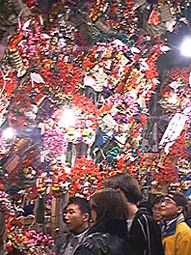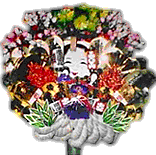ANNUAL CALENDAR November |
|
Tori no Ichi (The Festival of the Rooster)
|
 A number of Shinto shrines around the country hold a lively "festival of the rooster" in November. These festivals, which last throughout the night, are held on the days of the rooster in November, which in 2000 fall on November 11 and 23.
A number of Shinto shrines around the country hold a lively "festival of the rooster" in November. These festivals, which last throughout the night, are held on the days of the rooster in November, which in 2000 fall on November 11 and 23.
In the old Japanese calendar, modeled after the Chinese system, the years, days, and hours are represented by a repeating cycle of 12 animals: the rat, ox, tiger, rabbit, dragon, snake, horse, sheep, monkey, rooster, dog, and boar. For example, 1999 was the year of the rabbit. This means that 2000 is the year of the dragon, the next animal in the cycle. The purpose of these festivals, which have been held since the Edo period (1603-1868), is to pray for abundant harvests and prosperous sales. People also come to buy colorfully decorated kumade, or rakes, from the many vendors who set up stalls in and around the shrine. The biggest festival is held at the Otori Shrine in Asakusa, Tokyo, where some 200 stalls are set up and attracts tens of thousands of visitors every year.  Why are rakes sold on this day? They are used to "rake in" good fortune. The kumade come in a variety of sizes and are decorated with such good-luck items as masks, replicas of gold coins, and miniature treasure ships and chests. Some shop owners pray for greater prosperity by buying a slightly bigger kumade each year. Some shops with a long history have a kumade-buying tradition that goes back many generations.
Why are rakes sold on this day? They are used to "rake in" good fortune. The kumade come in a variety of sizes and are decorated with such good-luck items as masks, replicas of gold coins, and miniature treasure ships and chests. Some shop owners pray for greater prosperity by buying a slightly bigger kumade each year. Some shops with a long history have a kumade-buying tradition that goes back many generations.
In most years there are only two days of the rooster in November, but sometimes there are three. It's said that in such years, there will be many fires.
Photos: (Top) The stalls at Asakusa's Otori Shrine display innumerable kumade of different sizes and shapes (Kay Yokota); (above) the ornaments on a kumade very greatly, but a woman's mask is often placed in the center (Kametani Shoten). |
APR | MAY | JUN | JUL | AUG | SEP | OCT | NOV | DEC | JAN | FEB | MAR |
 |